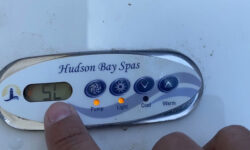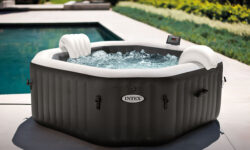You’ve noticed your hot tub’s acting up, getting hotter than it should. Overheating isn’t just a minor inconvenience, it’s a real danger.
Hot tub overheating is usually caused by a malfunctioning thermostat or a faulty heating element. The thermostat may be reading the water temperature incorrectly and causing the heater to run continuously. A malfunctioning high-limit switch, which is designed to turn off the heater when the water temperature reaches a certain point, can also cause overheating.
We’re here to delve into the common causes of hot tub overheating, guide you on fixing it yourself, and help you decide when it’s time to call in the pros.
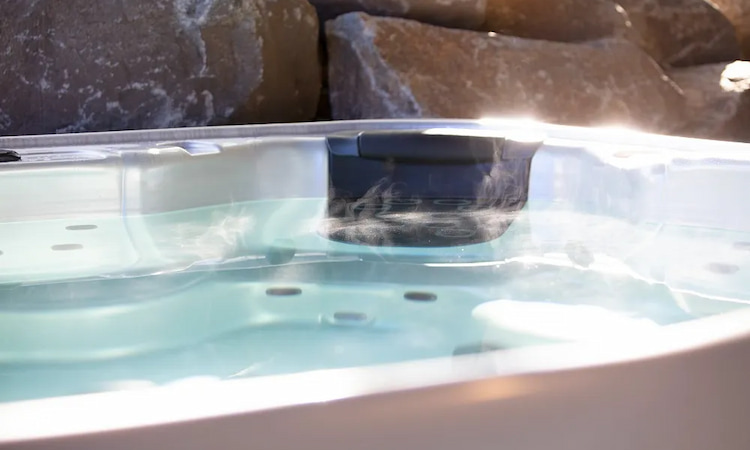
Quick Navigation
Can an Overheating Hot Tub Be Dangerous?
Experiencing an overheating hot tub can indeed be dangerous, posing serious risks to your health and safety.
Imagine you’re soaking up the warmth, not knowing the water’s temperature has escalated beyond the safe limit, which is typically around 104°F. Suddenly, you’re feeling faint or dizzy, and you’ve got an overheated tub to blame.
The immediate dangers of overheating include dizziness, fainting, heat exhaustion, or even heat stroke. These conditions can lead to severe health complications, especially for those with existing cardiovascular issues. It’s not just about physical discomfort, it’s about safeguarding your wellbeing.
In addition to these immediate risks, prolonged exposure to excessive heat can lead to dehydration. This isn’t merely about feeling thirsty, dehydration can impair your body’s natural cooling mechanism, further increasing your risk of heat-related illnesses.
Related Read: Is 107 Degrees Too Hot for a Hot Tub?
Common Causes of Hot Tubs to Overheat
To keep your hot tub from becoming a hazard, it’s crucial you understand the common causes of overheating.
Here are a few potential reasons:
- Faulty Thermostat: If your hot tub’s thermostat is out of whack, it can cause the water to heat beyond the set temperature. It’s a common issue and can usually be fixed by replacing the thermostat.
- Blocked Filters: A blocked filter makes it difficult for the water to circulate properly. This can cause the water in the hot tub to overheat. Regular maintenance and cleaning of filters can prevent this issue.
- Malfunctioning High-Limit Switch: This is a safety device designed to shut off the heating element when the water temperature reaches a particular point. If it’s faulty, the water can get dangerously hot.
Now that you’re aware of these common causes, you can pay close attention to your hot tub’s maintenance. If you notice any signs of overheating, don’t hesitate to call in a professional.
Things You Can Do To Deal With Overheating Hot Tub
If your hot tub’s behaving like a boiling cauldron, here’s what you can do to cool things down.
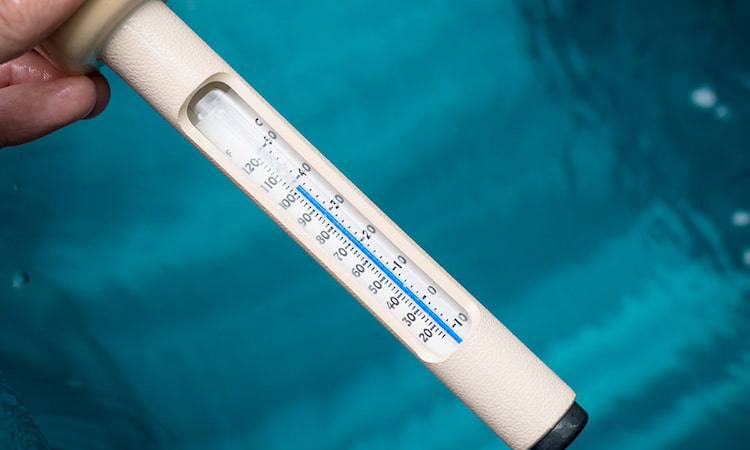
Firstly, check the thermostat. It could be set too high or malfunctioning. If it’s the former, adjust it to a more comfortable temperature. If it’s the latter, you may need to replace it.
Secondly, inspect your hot tub’s filter. A dirty or clogged filter can cause the water to heat up excessively. Regularly clean or replace it to maintain optimal performance. Also, ensure there’s adequate water flow. Restricted water flow due to blockages can lead to overheating.
Thirdly, look at the high limit switch, which prevents the tub from overheating. If it’s faulty, it can’t do its job, and you’ll need to replace it.
Lastly, consult a professional if you’re unsure or if the problem persists. Sometimes, sophisticated issues like a malfunctioning circuit board may be the culprit. If you’re not confident in dealing with electrical components, it’s always best to call in the experts.
Can Overheating Damage Your Hot Tub?
Yes, overheating can indeed damage your hot tub.
When the water in a hot tub is heated beyond its recommended temperature, it can cause several potential problems. Excessive heat can warp or damage the hot tub’s shell, leading to leakage or structural instability.
Furthermore, the heat can also damage the internal components of the tub, such as the pump, heater, and jets, reducing their efficiency or causing them to stop working altogether.
The electronic control system can also be impacted by excessive heat, leading to malfunctions.
When to Seek Professional Help?
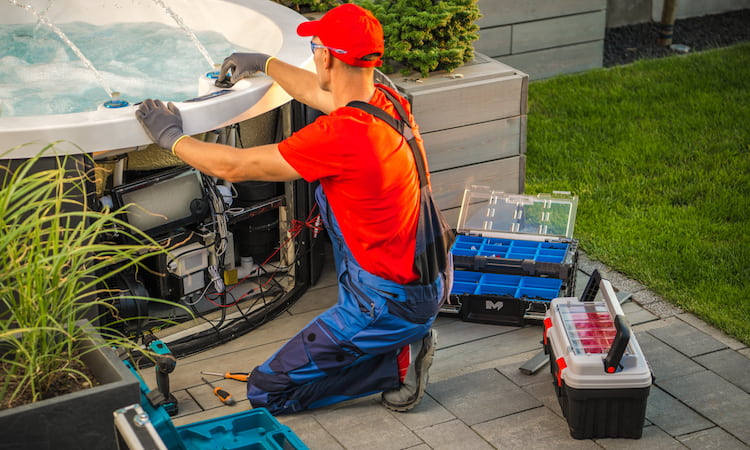
Don’t hesitate to contact a professional when your hot tub’s overheating issues persist despite your best troubleshooting efforts.
Sometimes, the problem might be more complex than you initially thought. It’s important to know when to step back and let a professional handle the situation to prevent further damage and unnecessary costs.
Here are a few signs that it’s time to seek professional help:
- The hot tub isn’t responding to any troubleshooting methods: If you’ve tried everything you can think of and the hot tub is still overheating, it’s time to call a professional. They have advanced diagnostic tools and the expertise to identify and fix the problem.
- You’re frequently dealing with the same issue: If the same problem keeps coming back, it could be a sign of a more serious underlying issue that needs a more thorough inspection.
- The hot tub has electrical issues: If your hot tub is tripping the circuit breaker, or if you’re seeing sparks or smoke, it’s vital to call a professional immediately. This could be a serious safety issue.
Measures to Take to Prevent Your Hot Tub From Overheating
After understanding when it’s necessary to call in a professional, let’s now focus on the steps you can take to prevent your hot tub from overheating in the first place.
Firstly, regulate the thermostat. It’s your main tool to control the water temperature. Don’t set it too high; a comfortable range is between 100°F and 102°F. Secondly, ensure good water flow. Blocked or dirty filters can reduce the flow, causing the heater to run too hot. Regular cleaning or replacement is a must.
Check the water level frequently. If it’s too low, the heater might work overtime and overheat. Also, a secure and well-insulated cover is essential. It prevents heat loss and maintains a steady temperature.
Lastly, consider the environment. High ambient temperature can contribute to overheating. If your hot tub is in direct sunlight, consider adding a shade.
Here’s a handy table:
| Measures | Description |
|---|---|
| Regulate Thermostat | Keep between 100°F – 102°F |
| Ensure Good Water Flow | Clean or replace filters regularly |
| Maintain Water Level | Refill if too low |
| Use Insulated Cover | Prevent heat loss |
| Consider Environment | Add shade if in direct sunlight |
Frequently Asked Questions
If you’re noticing your hot tub’s water is excessively hot, steam is more than usual, or the high limit switch trips frequently, it’s likely overheating. Check the thermostat, it might need adjusting or replacing.
You should ideally check your hot tub’s temperature daily. Regular monitoring allows you to detect slight changes in temperature, preventing potential overheating. It’s also essential during heavy usage or weather fluctuations.
Yes, weather conditions can contribute to your hot tub overheating. Extreme heat can cause water temperatures to rise, and strong sunlight can also increase heat. To prevent this, you can use a hot tub cover.
Yes, certain brands or models might be more prone to overheating. It’s vital to research and compare hot tub models before buying. Check for reviews mentioning overheating issues from current owners to ensure reliability.
Yes, your hot tub’s size can affect its overheating likelihood. Larger tubs require more energy to heat, potentially straining the heater. Regular maintenance and proper insulation help prevent this, regardless of your tub’s size.
Conclusion
In conclusion, an overheating hot tub can pose serious safety risks. Common culprits often involve faulty thermostats, blocked filters, or malfunctioning pumps.
You can troubleshoot these issues yourself but don’t hesitate to call a professional when needed. Regular maintenance is key in preventing overheating issues.


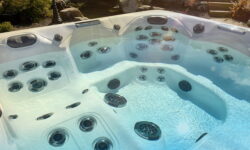

![What Causes Foaming in a Hot Tub? [& What to do] what causes foaming in a hot tub](https://hottubtales.com/wp-content/uploads/2022/12/what-causes-foaming-in-a-hot-tub.jpg)
